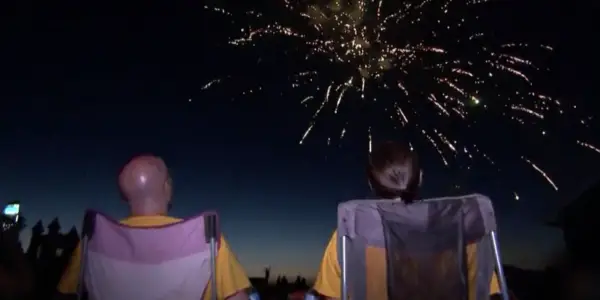ALTERNATE ENDINGS: An Honoring Look At End-Of-Life Alternatives

Carson Mlnarik is an entertainment journalist and social media coordinator…
There’s no way to sugarcoat that death is as much a part of life as well, life itself. Because it is inevitable, it feels uncontrollable and uncomfortable, and so as a society, we’ve created rules and traditions to adhere to in response. But what does a funeral, or a tombstone in a graveyard really mean anyway?
At a time when taking control of your own narrative is as prominent a theme as any, Alternate Endings: Six New Ways to Die in America feels as timely and natural as ever. 2018 marked the first time more Americans chose cremation over a traditional — and usually costly — funeral. The documentary takes a look at six non-traditional end-of-life options through the candid lens of people nearing death, and family members of the recently deceased. While a loss is never easy, the impactful vignettes highlight the meaning one can prescribe into their afterlife, and the healing that comes from staying true to someone’s legacy.
A Break from Tradition
The story begins with a grander look at the $16 billion a year funeral industry with the hustle and bustle of a Funeral Directors Conference. Services like holographic recordings and obituaries in 30-hours-or-less are advertised with an optimistic verve. Though at the heart of each and every “new way to die in America” is a family, and directors and producers Matthew O’Neill and Perri Peltz take great care in weaving their way through the six stories and the losses they’re connected to. The subject matter is tough and emotional but there’s a great sense of honor, respect, and healing from both the filmmakers and their subjects.

Each alternative is presented in a standalone short, introducing the option and leaving us to breathe with its respective subjects. Leila Johnson places the remains of her father, a man who lived for the sea, in a memorial reef that’s then placed in the ocean to create new habitats amidst a coral reef devastation. Guadalupe Cuevas, a beloved grandfather with terminal cancer, is celebrated while he’s still alive with a living wake where family and friends take photos, give emotional tributes and enjoy music and food.
Barbara Jean Simon chooses a spot for a green burial, where a new tree will be planted and she will be buried in biodegradable cloth as an environmentally-friendly alternative. Sara Snider Green and her kids watch a rocket launch with the remains of her father, a space enthusiast, and 44 other loved ones in a space burial. Dick Shannon opts for medical aid in dying, and goes out on his own terms after celebrations and moments with loved ones and friends. The parents of Garrett Matthias, a five-year-old who died of terminal cancer, throw him a celebration of life, remembering him through the carnival-like atmosphere he would have preferred over a somber ceremony.
“We can do the things that are important for us,” Emily Matthias says following her son’s celebration of life. “It’s okay to talk about what you want after you pass away.” She goes on to add that death “doesn’t have to be scary,” and each story presents a touching confrontation of that.
The Moments Between Moments
Documentaries about the nuances of death, final moments, and handling end-of-life options and care have been plentiful in the past few years – Dan Krauss’ Extremis and Rob Epstein and Jeffrey Friedman’s End Game are just a few. Challenging tradition and the norm may seem taboo in particular cultures and religions, while conversations about death are inherently sad and weighty.

Hesitations and heaviness aside, documentaries and shorts like these offer us a chance to glimpse into a stranger’s life as they confront the most unknown part of the human experience. It’s impossible not to be moved by memories and musings shared by these subjects nor is it possible to watch without reflecting on your relationship and experiences with loss.
What’s most striking about Alternate Endings, in particular, are the little moments that exist between every beat. Every frame of the documentary breathes humanity with tight shots of tearful eyes, obfuscating expressions, clenched hands and embraces, much thanks to candid cinematography by Taylor Krauss and O’Neill. The score by Jonathan Zalben is altogether soothing and suitable without ever venturing into saccharine.

The heavy moments– like Barbara Jean tearfully describing the power of love through the acts our loved ones do following our passing, and Sara Green accepting a book of memories about her father are balanced by lighter ones. Dick cracks jokes up to his last moments, and Batman makes an appearance for photos at Garrett Matthias’ celebration of life. Sometimes we laugh so we don’t cry, and sometimes we cry because that’s all we can do. Each story feels symbolically complete yet infinitely human and never static.
Alternate Endings: Conclusion
What is there to conclude from a film that closely follows families that so understandably don’t want to reach a conclusion? Grief is complex, and O’Neill and Peltz make sure the viewer walks away with a better understanding of how both remembrance and remaining to true to a loved one’s spirit and wishes can play into the healing process. What’s most powerful is the emphasis on these human subjects taking control of what end-of-life looks like in their own lives and legacies, and finding strength and solace in it.
It’s not a passive watch, it’s a powerful one, and dutifully so. Documenting an experience and process that is so universal is no easy task, but Alternate Endings find the perfect balance between exploration, education, and empathy and in doing so, assures us that through it all, we are not alone.
Have you considered a non-traditional end-of-life option for yourself or a family member? What do you think about the idea that documentary can help us explore a topic that might otherwise seem sad or taboo? Let us know in the comments below!
Alternate Endings: Six New Ways to Die in America was released on August 14, 2019 on HBO. For full release information, click here .
Does content like this matter to you?
Become a Member and support film journalism. Unlock access to all of Film Inquiry`s great articles. Join a community of like-minded readers who are passionate about cinema - get access to our private members Network, give back to independent filmmakers, and more.
Carson Mlnarik is an entertainment journalist and social media coordinator in New York City. He loves movies, Taylor Swift, and iced coffee. For more musings, follow him at twitter.com/carsonmlnarik.













